Investigation of the Mechanical Behavior of Polypropylene Fiber-Reinforced Red Clay
Abstract
:1. Introduction
2. Materials and Methods
2.1. Testing Materials
2.2. Specimen Preparation
2.3. Testing Method
3. Results and Discussion
3.1. Shear Strength of Fiber-Reinforced Red Clay
3.1.1. Effect of Fiber Content on Strength
3.1.2. Effect of Fiber Length on Strength
3.1.3. Effect of Cell Pressure on Strength
3.2. Constitutive Model for Fiber-Reinforced Red Clay
3.2.1. Model Establishment
3.2.2. Fitting of Model Parameters
3.2.3. Model Validation
4. Conclusions
- (1)
- The stress-strain curve of the fiber-reinforced red clay exhibited a typical strain-hardening property, which became more notable as FC and FL increased. The shear strength of the fiber-reinforced red clay significantly increased as FC, FL, and cell pressure increased.
- (2)
- The fiber could provide tensile resistance at a small deformation, thereby confining the extension of the failure surface and improving the shear strength. With an increases in FC and FL, the cohesion c of the fiber-reinforced red clay increased significantly, whereas the internal friction angle φ varied only slightly.
- (3)
- When considering the impact of cell pressure, FL, and FC, the results of the hyperbolic constitutive model coincide with test results well, confirming that the model can appropriately express the stress-strain relationship of the fiber-reinforced red clay.
Author Contributions
Funding
Institutional Review Board Statement
Informed Consent Statement
Data Availability Statement
Conflicts of Interest
References
- Wang, H.; Yang, G.Q.; Wang, Z.J.; Liu, W.C. Static structural behavior of geogrid reinforced soil retaining walls with a deformation buffer zone. Geotext Geomembr. 2020, 48, 374–379. [Google Scholar] [CrossRef]
- Zhang, R.; Long, M.X.; Lan, T.; Zheng, J.L.; Geoff, C. Stability analysis method of geogrid reinforced expansive soil slopes and its engineering application. J. Cent. South Univ. 2020, 27, 1965–1980. [Google Scholar] [CrossRef]
- Lee, S.L.; Mannan, M.A.; Ibrahim, W.H.W. Shear strength evaluation of composite pavement with geotextile as reinforcement at the interface. Geotext Geomembr. 2020, 48, 230–235. [Google Scholar] [CrossRef]
- Cicek, E. Experimental and theoretical investigation for highways incorporating geotextile design methodology. Road Mater. Pavement. 2018, 21, 965–984. [Google Scholar] [CrossRef]
- Li, L.; Fall, M. Shear behavior of marine clay-geomembrane interface under freeze-thaw cycles. J. Environ. Geotech. 2018, 172, 103006. [Google Scholar]
- Zeng, J.; Peng, X.X.; Ruan, B.; Li, X.S.; Zeng, Y. Experimental study on unconfined compressive strength of polypropylene fiber reinforced red clay. J. Railw. Sci. Eng. 2015, 12, 545–550. [Google Scholar]
- Gao, L.; Zhou, Q.Y.; Yu, X.J.; Wu, K.X.; Mahfouz, A.H. Experimental study on the unconfined compressive strength of carbon fiber reinforced clay soil. Mar. Georesour. Geotec. 2017, 35, 143–148. [Google Scholar] [CrossRef]
- Mirzababaei, M.; Arulrajah, A.; Haque, A.; Nimbalkar, S.; Mohajerani, A. Effect of fiber reinforcement on shear strength and void ratio of soft clay. Geosynth. Int. 2018, 25, 471–480. [Google Scholar] [CrossRef]
- Ozkul, Z.H.; Baykal, G. Shear strength of clay with rubber fiber inclusions. Geosynth. Int. 2006, 13, 173–180. [Google Scholar] [CrossRef]
- Kumar, A.; Walia, B.S.; Mohan, J. Compressive strength of fiber reinforced highly compressible clay. Constr. Build Mater. 2006, 20, 1063–1068. [Google Scholar] [CrossRef]
- Gao, C.H.; Du, G.Y.; Guo, Q.; Xia, H. Dynamic and static splitting-tensile properties of basalt fiber-reinforced cemented clay under freeze-thaw cycles. J. Mater. Civil. Eng. 2020, 32, 0003350. [Google Scholar] [CrossRef]
- Li, Q.; Chen, J.H.; Hu, H.X. The tensile and swelling behavior of cement-stabilized marine clay reinforced with short waste fibers. Mar. Georesour. Geotec. 2019, 37, 1236–1246. [Google Scholar] [CrossRef]
- Zhang, X.D.; Russell, A.R. Assessing liquefaction resistance of fiber-reinforced sand using a new pore pressure ratio. J. Geotech. Geoenviron. 2020, 146, 04019125. [Google Scholar] [CrossRef]
- Sargin, S.; Erken, A. Cyclic behavior and liquefaction resistance of polypropylene fiber-reinforced sands. Bull. Int. Inst. Seismol. Earthq. Eng. 2018, 52, 38–49. [Google Scholar]
- Sahu, R.; Ramaiah, J.; Ayothiraman, R.; Gunturi, R. Dynamic properties of human hair fiber-reinforced Yamuna sand. J. Test Eval. 2019, 48, 20180133. [Google Scholar] [CrossRef]
- Rafalko, S.D.; Brandon, T.L.; Filz, G.M.; Mitchell, J.K. Fiber reinforcement for rapid stabilization of soft clay soils. Transp. Res. Rec. J. Transp. Res. Board 2007, 2026, 21–29. [Google Scholar] [CrossRef] [Green Version]
- Boz, A.; Sezer, A. Influence of fiber type and content on freeze-thaw resistance of fiber reinforced lime stabilized clay. Cold Reg. Sci. Technol. 2018, 151, 359–366. [Google Scholar] [CrossRef]
- Tomar, A.; Sharma, T.; Singh, S. Strength properties and durability of clay soil treated with mixture of nano silica and polypropylene fiber. Mater. Today Proc. 2020, 26, 3449–3457. [Google Scholar] [CrossRef]
- Estabragh, A.R.; Namdar, P.; Javadi, A.A. Behavior of cement-stabilized clay reinforced with nylon fiber. Geosynth. Int. 2012, 19, 85–92. [Google Scholar] [CrossRef]
- Gao, L.; Hu, G.H.; Xu, N.; Fu, J.Y.; Xiang, C.; Yang, C. Experimental study on unconfined compressive strength of basalt fiber reinforced clay soil. Adv. Mater. Sci. Eng. 2015, 2015, 561293. [Google Scholar] [CrossRef] [Green Version]
- Basson, M.S.; Ayothiraman, R. Effect of human hair fiber reinforcement on shrinkage cracking potential of expensive clay. B Eng. Geol. Environ. 2020, 79, 2159–2168. [Google Scholar] [CrossRef]
- Anggraini, V.; Asadi, A.; Farzadnia, N.; Jahangirian, H.; Huat, B.B.K. Reinforcement benefits of nanomodified coir fiber in lime-treated marine clay. J. Mater. Civil.Eng. 2016, 28, 06016005. [Google Scholar] [CrossRef]
- Olgun, M. Effects of polypropylene fiber inclusion on the strength and volume change characteristics of cement-fly ash stabilized clay soil. Geosynth. Int. 2013, 20, 263–275. [Google Scholar] [CrossRef]
- Kravchenko, E.; Liu, J.K.; Krainiukov, A.; Chang, D. Dynamic behavior of clay modified with polypropylene fiber under freeze-thaw cycles. Transp. Geotech. 2019, 21, 100282. [Google Scholar] [CrossRef]
- Xue, Q.; Lu, H.J.; Li, Z.Z.; Liu, L. Cracking, water permeability and deformation of compacted clay liners improved by straw fiber. Eng. Geol. 2014, 178, 82–90. [Google Scholar]
- Jiang, Z.L.; Wang, C.G.; Xiao, W.; Ruan, B. Laboratory investigation and numerical simulation of unconfined compressive strength of glass fiber reinforced soil. J. Railw. Sci. Eng. 2020, 17, 1404–1410. [Google Scholar]
- Dong, J.; Chen, J.; Wu, Z.H.; Yang, H.; Chen, T.X. Experimental study on the shear strength and deformation characteristics of lignin-fiber red clay. J. Geomech. 2019, 25, 421–427. [Google Scholar]
- Wan, Y.Y.; Peng, X.X. Experimental study on compression properties of glass fiber and lime reinforced red clay. Highw. Eng. 2017, 42, 281–284. [Google Scholar]
- Chen, J.Y.; Liu, Z.K.; Chen, Y.G.; Xi, D.N. Orthogonal test and multivariate nonlinear regression analyses of strength of the fiber red clay. Hydrogeol. Eng. Geol. 2020, 47, 117–124. [Google Scholar]
- Gao, L.; Hu, G.H.; Chen, Y.H.; Hu, Y.J.; Gong, Y.H. Triaxial tests clay reinforced by basalt fiber. Chin. J. Geotech. Eng. 2017, 39, 198–203. [Google Scholar]
- Liu, T. Experimental investigation on the static and dynamic characteristics of silty clay reinforced with basalt fiber. J. Railw. Sci. Eng. 2020, 17, 1734–1742. [Google Scholar]
- Duncan, J.M.; Chang, C.Y. Nonlinear analysis of stress and strain in soils. J. Soil Mech. Found. Div. ASCE 1970, 96, 1629–1653. [Google Scholar] [CrossRef]
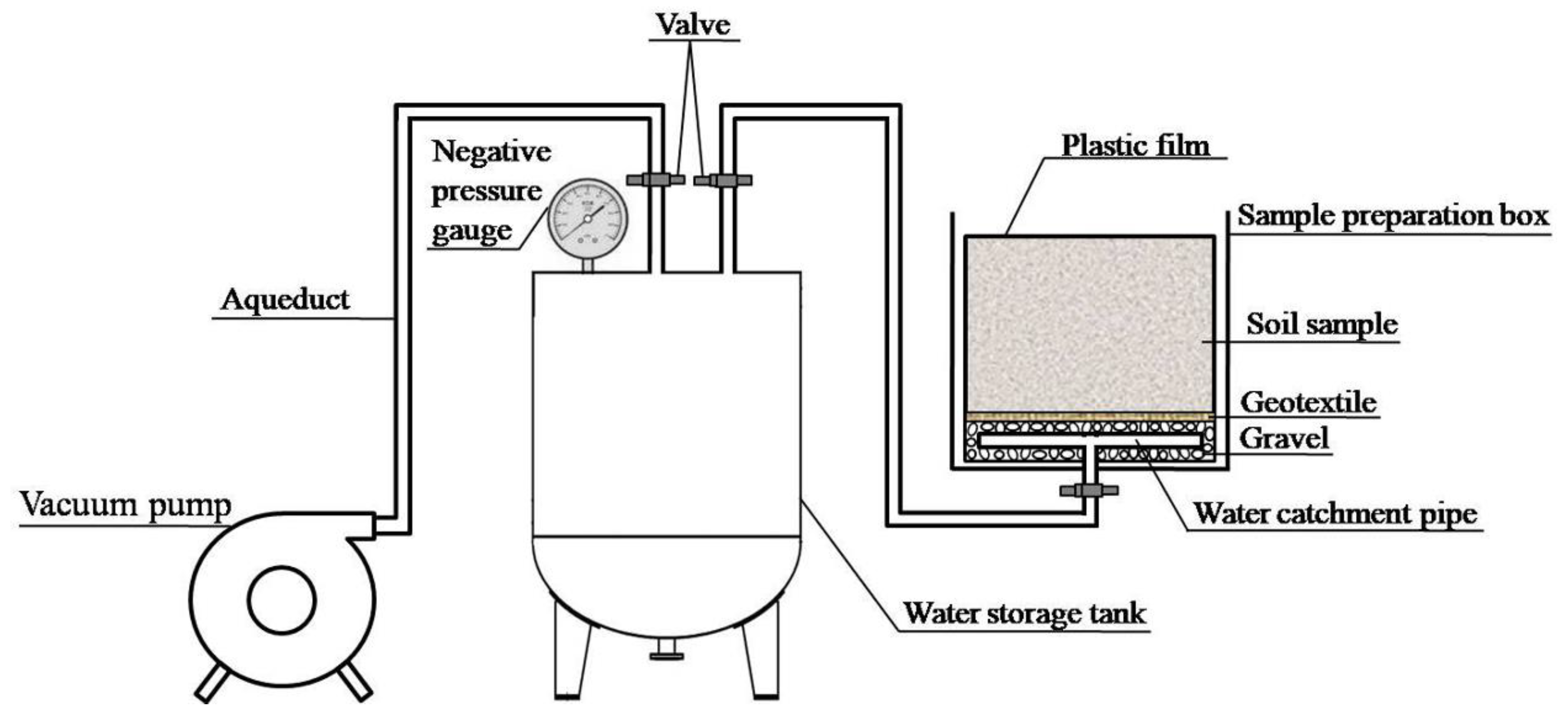
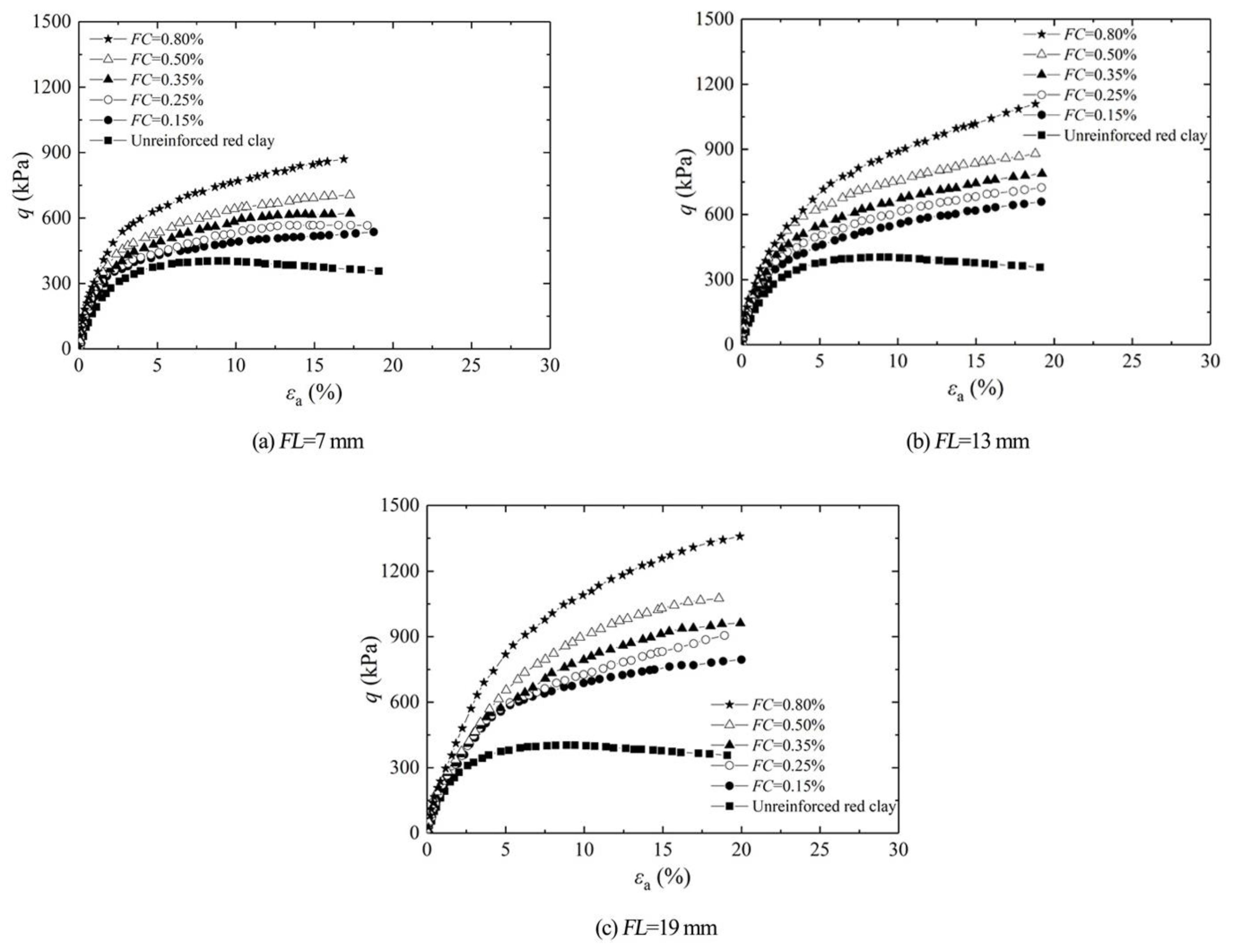
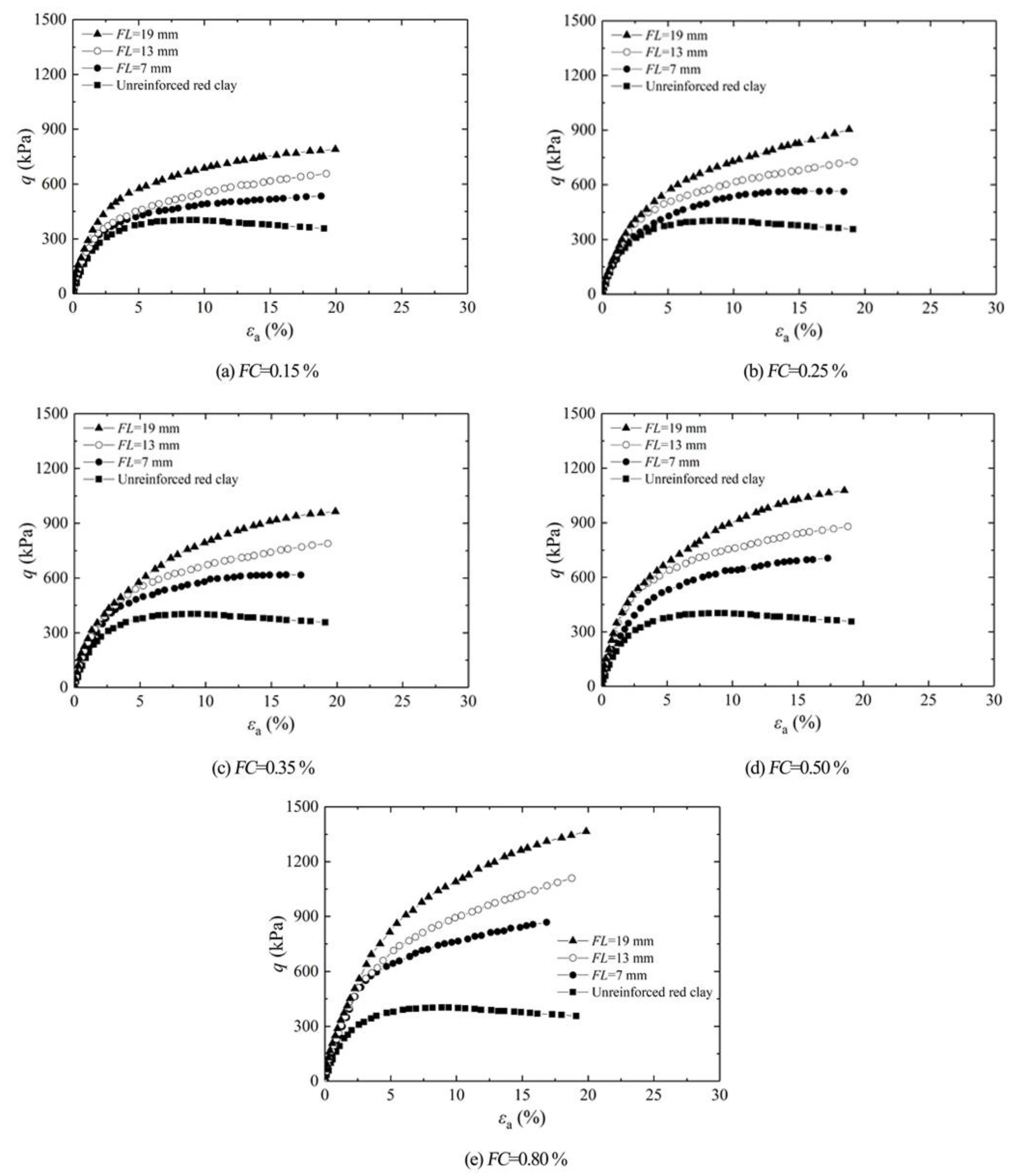
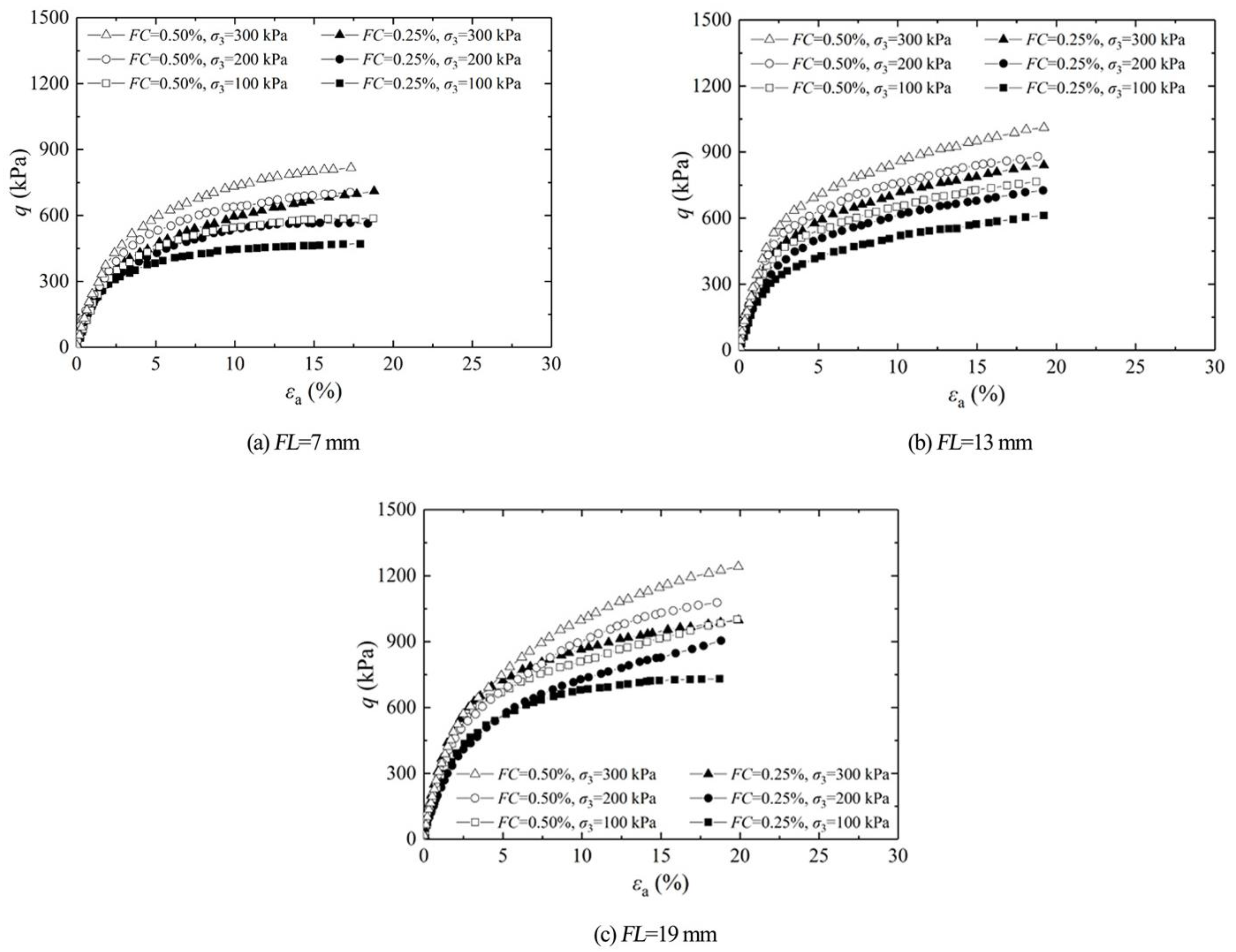
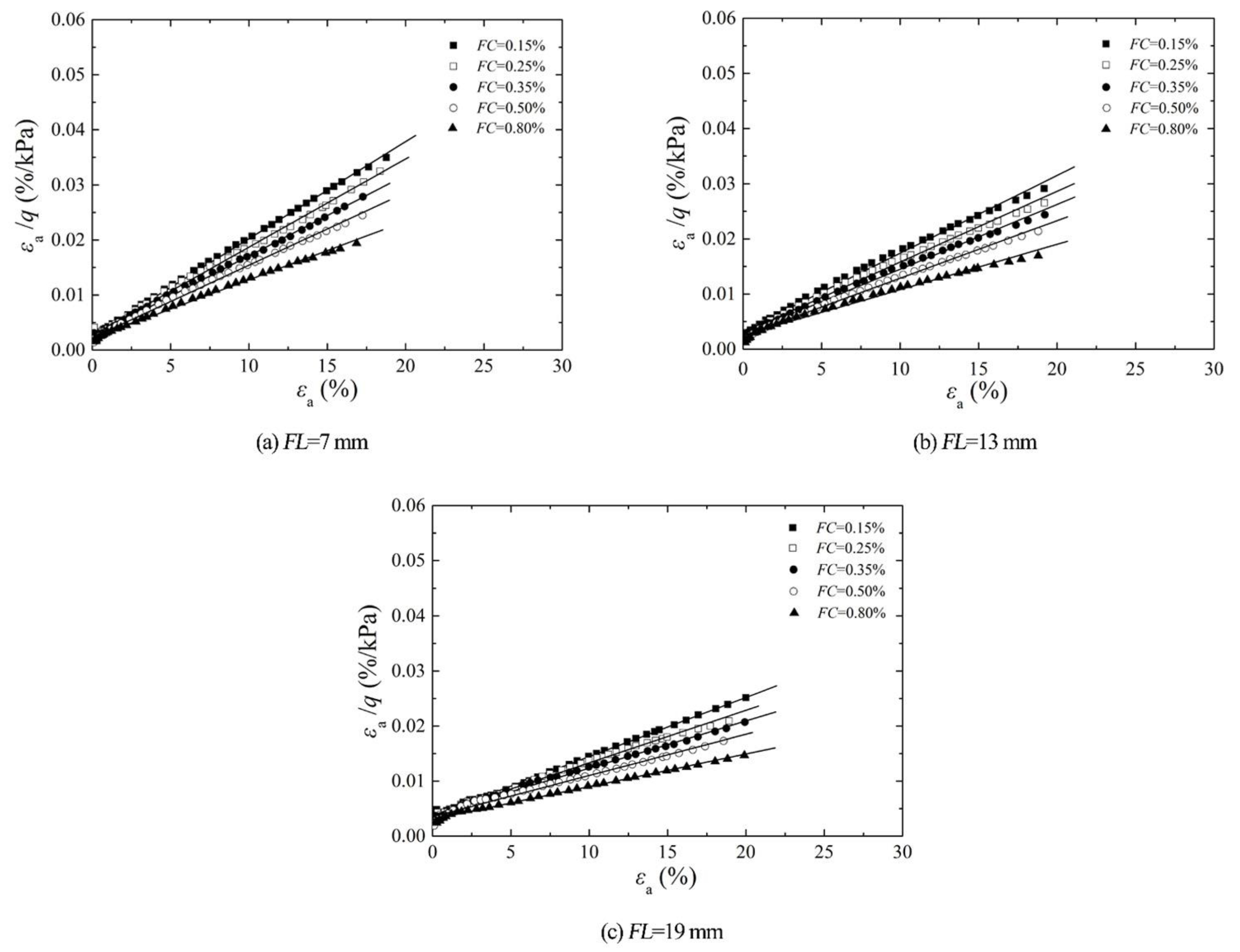
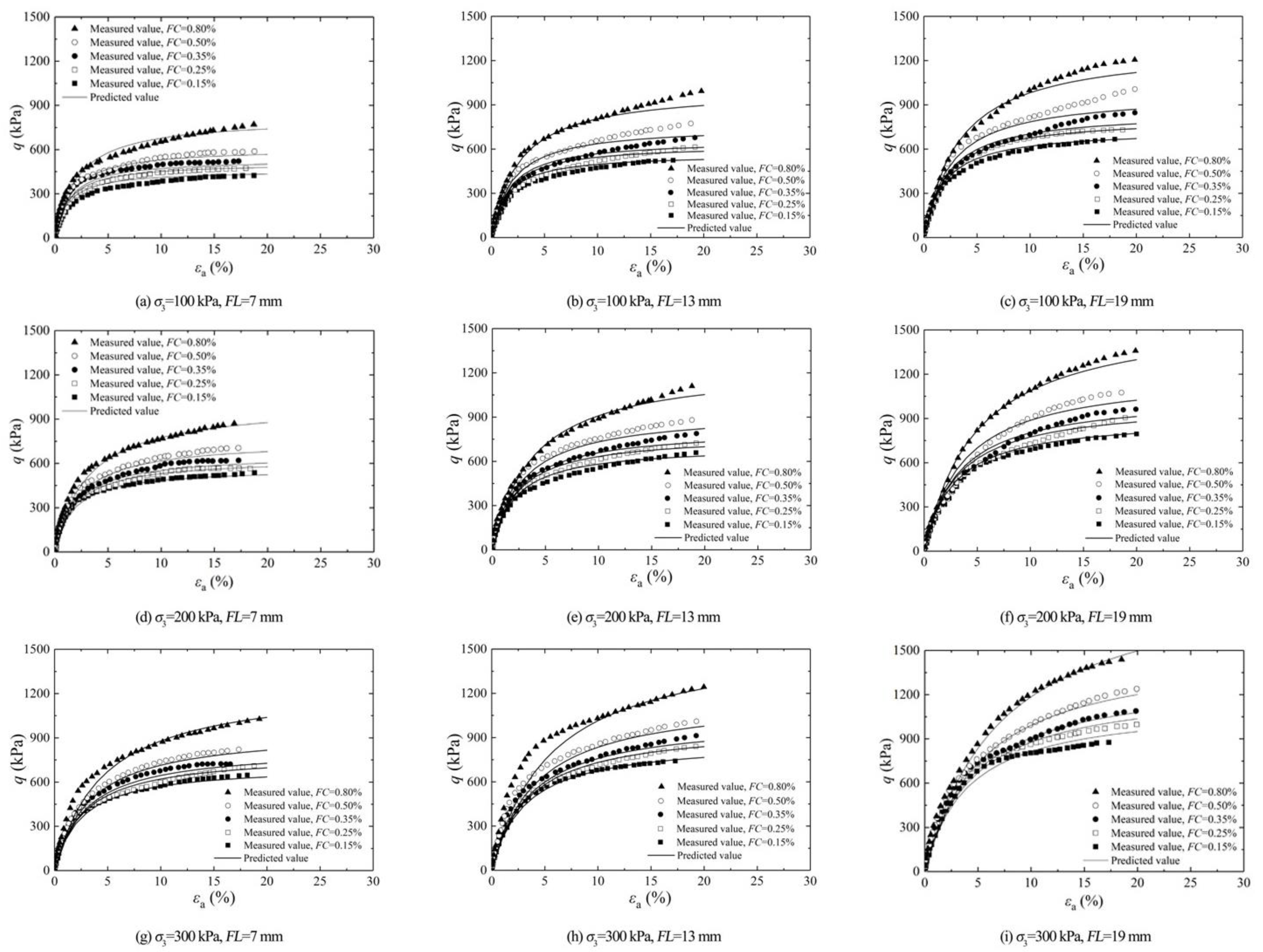
| Parameters | w/% | wop/% | wP/% | wL/% | IP | ρ/(g/cm3) | ρdmax/(g/cm3) |
|---|---|---|---|---|---|---|---|
| Values | 8.5 | 16.8 | 17.1 | 33.4 | 16.3 | 1.65 | 1.83 |
| Parameters | Values |
|---|---|
| Linear density/dtex | 7.33 |
| Diameter d/mm | 0.025 |
| Gravity γ/(g/cm3) | 0.91 |
| Tensile strength/MPa | 592 |
| Elongation at break/% | 26.4 |
| Initial elasticity modulus/MPa | 4479 |
| Fusion point/°C | 163 |
| Ignition point/°C | 590 |
| Resistance of acidity and basicity | High |
| σ3 (kPa) | FL (mm) | FC (%) |
|---|---|---|
| 100 | 0 | 0 |
| 7 | 0.15, 0.25, 0.35, 0.50, 0.80 | |
| 13 | 0.15, 0.25, 0.35, 0.50, 0.80 | |
| 19 | 0.15, 0.25, 0.35, 0.50, 0.80 | |
| 200 | 0 | 0 |
| 7 | 0.15, 0.25, 0.35, 0.50, 0.80 | |
| 13 | 0.15, 0.25, 0.35, 0.50, 0.80 | |
| 19 | 0.15, 0.25, 0.35, 0.50, 0.80 | |
| 300 | 0 | 0 |
| 7 | 0.15, 0.25, 0.35, 0.50, 0.80 | |
| 13 | 0.15, 0.25, 0.35, 0.50, 0.80 | |
| 19 | 0.15, 0.25, 0.35, 0.50, 0.80 |
| Fiber Length FL/mm | Fiber Content FC/% | Cohesion c/kPa | Angle of Internal Friction φ/(°) |
|---|---|---|---|
| 0 | 0 | 93.25 | 14 |
| 7 | 0.15 | 106.42 | 20 |
| 0.25 | 125.16 | 20 | |
| 0.35 | 142.20 | 20 | |
| 0.50 | 163.58 | 20 | |
| 0.80 | 208.41 | 22 | |
| 13 | 0.15 | 141.30 | 20 |
| 0.25 | 160.85 | 21 | |
| 0.35 | 180.19 | 21 | |
| 0.50 | 211.54 | 21 | |
| 0.80 | 269.04 | 21 | |
| 19 | 0.15 | 188.33 | 20 |
| 0.25 | 211.19 | 21 | |
| 0.35 | 234.01 | 21 | |
| 0.50 | 270.95 | 22 | |
| 0.80 | 349.52 | 22 |
| σ3 (kP) | FL (mm) | FC (%) | a | b | a1 | a2 | R2 | a1* | a2* |
|---|---|---|---|---|---|---|---|---|---|
| 200 | 7 | 0.15 | 0.00269 | 0.00176 | 0.00269 | 0.00370 | 0.99966 | 0.00300 | 0.00370 |
| 7 | 0.25 | 0.00268 | 0.00161 | 0.00268 | 0.00564 | 0.99896 | 0.00554 | ||
| 7 | 0.35 | 0.00251 | 0.00147 | 0.00251 | 0.00720 | 0.99909 | 0.00739 | ||
| 7 | 0.50 | 0.00235 | 0.00132 | 0.00235 | 0.00924 | 0.99848 | 0.00924 | ||
| 7 | 0.80 | 0.00222 | 0.00106 | 0.00222 | 0.01187 | 0.99817 | 0.01109 | ||
| 13 | 0.15 | 0.00343 | 0.00141 | 0.00343 | 0.00550 | 0.99747 | 0.00554 | ||
| 13 | 0.25 | 0.00305 | 0.00128 | 0.00305 | 0.00832 | 0.99734 | 0.00832 | ||
| 13 | 0.35 | 0.00283 | 0.00118 | 0.00283 | 0.01074 | 0.99703 | 0.01109 | ||
| 13 | 0.50 | 0.00254 | 0.00104 | 0.00254 | 0.01352 | 0.99819 | 0.01386 | ||
| 13 | 0.80 | 0.00265 | 0.00082 | 0.00265 | 0.01706 | 0.99340 | 0.01663 | ||
| 19 | 0.15 | 0.00385 | 0.00107 | 0.00385 | 0.00610 | 0.99940 | 0.00628 | ||
| 19 | 0.25 | 0.00387 | 0.00095 | 0.00387 | 0.00903 | 0.99755 | 0.00942 | ||
| 19 | 0.35 | 0.00376 | 0.00086 | 0.00376 | 0.01144 | 0.99748 | 0.01257 | ||
| 19 | 0.50 | 0.00352 | 0.00075 | 0.00352 | 0.01425 | 0.99262 | 0.01571 | ||
| 19 | 0.80 | 0.00305 | 0.00059 | 0.00305 | 0.01794 | 0.99771 | 0.01885 |
| σ3 (kP) | FL (mm) | FC (%) | a | b | a1 | a2 | R2 | a1* | a2* |
|---|---|---|---|---|---|---|---|---|---|
| 100 | 7 | 0.15 | 0.00304 | 0.00218 | 0.00304 | 0.00229 | 0.99941 | 0.00250 | 0.00229 |
| 7 | 0.25 | 0.00242 | 0.00194 | 0.00242 | 0.00340 | 0.99989 | 0.00344 | ||
| 7 | 0.35 | 0.00152 | 0.00182 | 0.00152 | 0.00446 | 0.99982 | 0.00458 | ||
| 7 | 0.50 | 0.00171 | 0.00160 | 0.00171 | 0.00560 | 0.99901 | 0.00573 | ||
| 7 | 0.80 | 0.00184 | 0.00124 | 0.00184 | 0.00694 | 0.99696 | 0.00687 | ||
| 13 | 0.15 | 0.00318 | 0.00171 | 0.00318 | 0.00334 | 0.99947 | 0.00344 | ||
| 13 | 0.25 | 0.00328 | 0.00148 | 0.00328 | 0.00481 | 0.99847 | 0.00515 | ||
| 13 | 0.35 | 0.00296 | 0.00134 | 0.00296 | 0.00610 | 0.99853 | 0.00687 | ||
| 13 | 0.50 | 0.00212 | 0.00121 | 0.00212 | 0.00787 | 0.99795 | 0.00859 | ||
| 13 | 0.80 | 0.00205 | 0.00094 | 0.00205 | 0.00978 | 0.99713 | 0.01031 | ||
| 19 | 0.15 | 0.00303 | 0.00134 | 0.00303 | 0.00382 | 0.99979 | 0.00389 | ||
| 19 | 0.25 | 0.00252 | 0.00120 | 0.00252 | 0.00570 | 0.99988 | 0.00584 | ||
| 19 | 0.35 | 0.00294 | 0.00105 | 0.00294 | 0.00698 | 0.99787 | 0.00779 | ||
| 19 | 0.50 | 0.00257 | 0.00090 | 0.00257 | 0.00855 | 0.99734 | 0.00973 | ||
| 19 | 0.80 | 0.00234 | 0.00071 | 0.00234 | 0.01079 | 0.99629 | 0.01168 | ||
| 300 | 7 | 0.15 | 0.00361 | 0.00140 | 0.00361 | 0.00441 | 0.99916 | 0.00350 | 0.00441 |
| 7 | 0.25 | 0.00348 | 0.00131 | 0.00348 | 0.00688 | 0.99663 | 0.00662 | ||
| 7 | 0.35 | 0.00339 | 0.00122 | 0.00339 | 0.00897 | 0.99945 | 0.00882 | ||
| 7 | 0.50 | 0.00325 | 0.00108 | 0.00325 | 0.01134 | 0.99890 | 0.01103 | ||
| 7 | 0.80 | 0.00314 | 0.00090 | 0.00314 | 0.01512 | 0.99801 | 0.01323 | ||
| 13 | 0.15 | 0.00383 | 0.00117 | 0.00383 | 0.00684 | 0.99991 | 0.00662 | ||
| 13 | 0.25 | 0.00367 | 0.00107 | 0.00367 | 0.01043 | 0.99877 | 0.00992 | ||
| 13 | 0.35 | 0.00343 | 0.00099 | 0.00343 | 0.01351 | 0.99836 | 0.01323 | ||
| 13 | 0.50 | 0.00336 | 0.00090 | 0.00336 | 0.01755 | 0.99865 | 0.01654 | ||
| 13 | 0.80 | 0.00327 | 0.00074 | 0.00327 | 0.02309 | 0.99845 | 0.01985 | ||
| 19 | 0.15 | 0.00369 | 0.00098 | 0.00369 | 0.00838 | 0.99913 | 0.00750 | ||
| 19 | 0.25 | 0.00364 | 0.00088 | 0.00364 | 0.01254 | 0.99966 | 0.01125 | ||
| 19 | 0.35 | 0.00363 | 0.00081 | 0.00363 | 0.01616 | 0.99800 | 0.01499 | ||
| 19 | 0.50 | 0.00361 | 0.00070 | 0.00361 | 0.01995 | 0.99621 | 0.01874 | ||
| 19 | 0.80 | 0.00353 | 0.00058 | 0.00353 | 0.02645 | 0.99498 | 0.02249 |
Publisher’s Note: MDPI stays neutral with regard to jurisdictional claims in published maps and institutional affiliations. |
© 2021 by the authors. Licensee MDPI, Basel, Switzerland. This article is an open access article distributed under the terms and conditions of the Creative Commons Attribution (CC BY) license (https://creativecommons.org/licenses/by/4.0/).
Share and Cite
Liu, J.; Li, X.; Li, G.; Zhang, J. Investigation of the Mechanical Behavior of Polypropylene Fiber-Reinforced Red Clay. Appl. Sci. 2021, 11, 10521. https://doi.org/10.3390/app112210521
Liu J, Li X, Li G, Zhang J. Investigation of the Mechanical Behavior of Polypropylene Fiber-Reinforced Red Clay. Applied Sciences. 2021; 11(22):10521. https://doi.org/10.3390/app112210521
Chicago/Turabian StyleLiu, Jia, Xi’an Li, Gang Li, and Jinli Zhang. 2021. "Investigation of the Mechanical Behavior of Polypropylene Fiber-Reinforced Red Clay" Applied Sciences 11, no. 22: 10521. https://doi.org/10.3390/app112210521
APA StyleLiu, J., Li, X., Li, G., & Zhang, J. (2021). Investigation of the Mechanical Behavior of Polypropylene Fiber-Reinforced Red Clay. Applied Sciences, 11(22), 10521. https://doi.org/10.3390/app112210521






